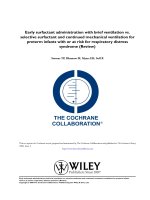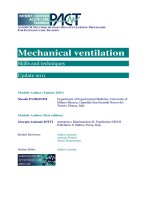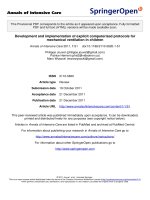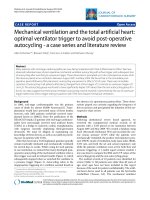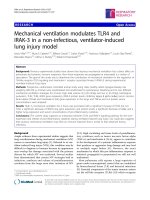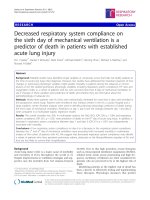Mechanical ventilation workshop
Bạn đang xem bản rút gọn của tài liệu. Xem và tải ngay bản đầy đủ của tài liệu tại đây (1011.03 KB, 40 trang )
Mechanical
Ventilation
Workshop
J. Christopher Farmer
“Play by the Rules”
Basic Principles:
Establish Harm-Free Goals
1.
SaO2 85-90% with certain exceptions
2.
Follow pH not PaCO2
3.
VT: ARDS versus other lung conditions
4.
Paw: ARDS versus other lung conditions
5.
Avoid drugs that may prolong weaning
(sedatives, neuromuscular blockers)
Better is the enemy of good…
Basic Principles:
Establish Synchronization
VENTILATOR
DELIVERY
•
•
•
FLOW
PRESSURE
VOLUME
PATIENT
DEMAND
Basic Principles:
Avoid Lung Injury
ALVEOLAR
SHEAR
• PRESSURE
• VOLUME
COLLAPSE RECRUITMENT
Basic Principles:
The Target Zone
Basic Principles:
Lung immobilization = healing
Basic Principles:
Coordination of Purpose
patient
}P
res
P
Airway
P
PAlv
Pleura
ventilator
Diaphragm
Airway pressure
Flow
Ti
Stroetz et al.
Te
Time
Basic Principles:
Know the Modes
CPAP
Basic Principles:
Know the Modes
SIMV
Basic Principles:
Know the Modes
SIMV + PRESSURE SUPPORT
SIMV
Basic Principles:
Know the Modes
ASSIST CONTROL (CMV)
Basic Principles:
Know the Modes
CMV versus PC
Basic Principles:
Know the Modes
I
APRV
E
Basic Principles:
Know the Waveforms
Basic Principles:
Know the Waveforms
What is the flow pattern?
Basic Principles:
Know the Waveforms
Is this a pressure supported or SIMV or VAC breath?
Basic Principles:
Know the Waveforms
Is this pressure support or pressure control?
Basic Principles:
Know the Waveforms
INADEQUATE
INSP. FLOW
X
Is the patient/ventilator synchronizing with the patient/ventilator?
Basic Principles:
Know the Waveforms
VENTILATOR TUBING CIRCUIT LENGTH
PATIENT
VENTILATOR
Inspiratory effort: patient work with pressure versus flow triggering
“Diagnosing the problem”
Disorders of flow
Flow starvation
Excess flow
Outflow obstruction
Inflow obstruction
Flow Starvation
CMV, Volume Cycled
Inspiratory Flow Starvation
High respiratory drive
High inspiratory flow
demand
Pain
Fever
Anxiety
Patient outstripping
the pre-set (fixed)
ventilator flow rate
Scalping of pressure
waveform
Adjust Peak Flow to Meet
Patient Inspiratory Demand



